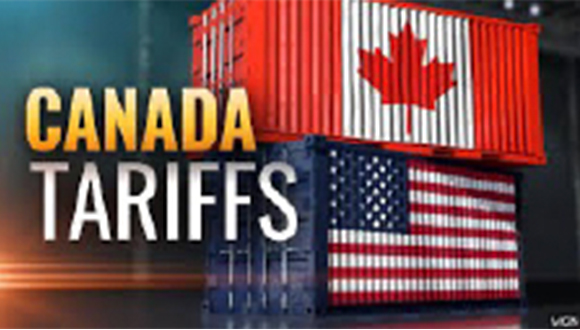On Tuesday, U.S. President Donald Trump ordered, effective March 4th, 25% tariffs on Canadian imports with the exception of energy, which would be subject to a 10% tariff.
Later that day, Prime Minister Trudeau announced Canada’s response to the U.S. tariffs:
- In response to the U.S. tariffs, the Government of Canada is moving forward with 25 percent tariffs on $30 billion worth of imported goods, beginning immediately. The list includes products such as appliances and certain pulp and paper products. List of goods in first phase ($30 billion in goods).
- Should the U.S. continue to apply unjustified tariffs on Canada, the government intends to impose additional countermeasures on $125 billion in imports from the U.S. The list includes products such as electronics, steel, aluminium, and more. Second Phase list of goods.
- The government is taking steps to mitigate the impact of these countermeasures on Canadian workers and businesses by establishing a remission process to consider requests for exceptional relief from the tariffs imposed as part of our response to the U.S. applying unjustified tariffs on Canada. Details on Remission Process.
- Some Provinces will also enact relief programs for businesses affected by the tariffs
- Government procurement have been banned or severely restricted in many provinces, including Ontario, British Columbia, and the Maritime Provinces
- If tariffs persist or retaliatory tariffs are enacted, Ontario will immediately implement a 25% surcharge on the electricity we export.
On Tuesday, the U.S. government also doubled the 10 percent tariff placed on China to 20 percent.
On Wednesday afternoon, President Donald Trump then announced a one-month exemption on his stiff new tariffs on imports from Mexico and Canada for U.S. automakers, amid fears that the trade war could harm U.S. manufacturers.
The announcement comes after Trump spoke with leaders of the “Big 3” automakers on Wednesday: Ford, General Motors, and Stellantis. Trump also said he told the automaker chief executives that they should move production to the U.S. from Canada and Mexico, according to White House press secretary Karoline Leavitt.
“We spoke with the big three auto dealers,” Trump said in a statement read by his spokesperson. “We are going to give a one-month exemption on any autos coming through USMCA,” referencing the North American free trade agreement he renegotiated in his first term.”
Trump’s press secretary said the president is open to hearing about additional exemptions, but Canadian Prime Minister Justin Trudeau is not willing to lift Canada’s retaliatory tariffs if Trump leaves any tariffs on Canada, a senior government official told the press.
“Both countries will continue to be in contact,” Trudeau’s office said yesterday.
On March 6th, U.S. President Donald Trump granted most imports from Mexico a temporary reprieve from the 25-percent tariffs enacted on Mar. 4th, and U.S. Secretary of Commerce Howard Lutnick said he expects the White House will do the same for Canada.
The commerce secretary stated that Trump plans to remove 25% tariffs on goods that comply with the US-Mexico-Canada Agreement trade deal rules, covering most Canadian exports to US customers. The US currently imposes a 10% tariff on Canadian energy and critical minerals. On April 2, Washington plans to impose reciprocal tariffs on foreign trading partners for taxes, duties, or barriers deemed unfair to US companies.
Impacted product categories for CHPTA members in the first phase of counter-tariffs by Canada include:
- Plastic building materials, including flooring, shutters, blinds, and doors.
- Bathroom appliances and accessories, including bathtubs, toilet seats, showers, and sinks.
- Kitchenware, tableware, and glassware, including forks, spoons, knives, and cups.
- Lumber and wood products, including plywood, beams, fiberboard, windows, shingles, flooring, doors, and doorframes.
- Camping and other outdoor equipment, including tents, tarps, mattresses, rock climbing harnesses, life jackets, and sails.
- Towels, duster, dish, and other cleaning cloths.
- Kitchen appliances, including stoves, microwaves, bread makers, hot plates, toasters, coffee makers, and portable stoves.
- Vacuum Cleaners
- Fans
- Dishwashers, refrigerators, freezers, and laundry machines.
- Snow plows, snow blowers, and lawnmowers.
- Tools such as saws, wrenches, drills, hammers, and screwdrivers.
- Cutting knives
- Padlocks
- Shaving products, including razors, shaving cream, and aftershave.
- Electric hair accessories, including dryers and irons.
- Lights, lamps, Christmas lights, and light fixtures.
The Canadian government is now seeking public views on the second list of counter-tariffs over the next 21 days (by March 25). If there are products and/or inputs (indicate by the HS Code(s)) on that list that your company would like to have excluded from the tariff list, you can forward your comments to the Depart of Finance – click here.
We will continue to monitor the tariff situation and provide updates to you in a timely manner.
In addition, please join our Slack Channel and follow the conversation and share updates with fellow industry professionals in housewares and hardware on how these tariffs will affect your business.












